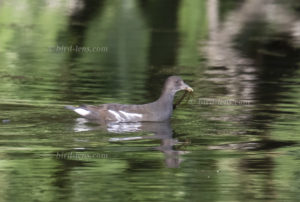 The general area of Fajã Grande has a great potential for Birdwatching. Die different habitats include lagoons, streams, woods, coastal areas, small pastures, agricultural fields and 1 little lake. This is a place of magnificent beauty. Take the parking spot on the road between 2 bridges and walk from the main road up to the lake.
The general area of Fajã Grande has a great potential for Birdwatching. Die different habitats include lagoons, streams, woods, coastal areas, small pastures, agricultural fields and 1 little lake. This is a place of magnificent beauty. Take the parking spot on the road between 2 bridges and walk from the main road up to the lake.
By a pedestrian, partly steep path in good condition of less than 1 km you will come to the center of Ribeira do Ferreiro. Here is located a lake also called Lagoa dos Patos or Alagoinha. Numerous waterfalls are feeding a pond, used by ducks. This is also the place where you can observe the resident Common Moorhen (Gallinula chloropus) which is called the Galinha-d’água in portugues. Considered a subspecies endemic by some authors, it has been registered in the Azores for a long time. At present, this species only nests in four islands of the Azores and its nesting population is said to be only 30-40 couples. It occurs in water bodies associated with riparian vegetation, although it is not very demanding with respect to the amount of water.
Best is a visit in the afternoon hours when the sun from west lights the steep cliffs and the waterfalls, the cascades in beautiful tones. During a hike on the excellent stony trail we were able to see an adult and a juvenile Common Moorhen very well. A surprise was a bathing female Blue-winged Teal (Anas discors) which was preening extensively in the best sunlight for a prolonged time on a log lying in the water.
In the forests which give access to the lagoon, it is possible to observe the Eurasian Woodcock (Scolopax rusticola) and resident Passeriformes as the Blackcap (Sylvia atricapilla) or the Grey Wagtail (Motacilla cinerea). In Fall there is always the possibility of observations of migratory Passeriformes of rare occurrence.
Fajã Grande is convincing not only birding-wise. A few minutes from the village there are several natural swimming pools, bathing facilities under the waterfalls, two restaurants and a few small pubs, a balneario with a children’s swimming pool and shower facilities. And in the evening enjoy the “westernmost sunset of Europe” over the Atlantic …
From the coast you might see the Cagarro, the Cory’s Shearwater (Calonectris borealis). This is perhaps the best known bird of the Azoreans and, certainly, one of the most emblematic of the archipelago. Famous is their characteristic nocturnal “vozear” – sound. Especially at the end of summer and early fall you might come in contact with young birds that are found, disoriented by the light of the earth, on roads, paths, streets, etc.
Due to the maritime climate, there is not really a best season to name. So, in general Flores is a perfect birding all-year-destination, maybe except summer
In order to satisfy the growing demand for top shots of the rarer species of Western Palearctic, Bird-lens.com has undertaken dedicated trips to nearby and distant bird areas. This is to be able to do anything to provide excellent images of the birds of the Western Palearctic. Sometimes the yield of images is enriched by bird species, which are very unlikely to show-up in the Western Palearctic. The results in images even of rare Western Palearctic birds are very good. The beautiful images of the blog are only a first impression of what you will find in behind “Picture Shop” very soon. Simply contact bird-lens.com if you need an image of a bird before the newest images are online.